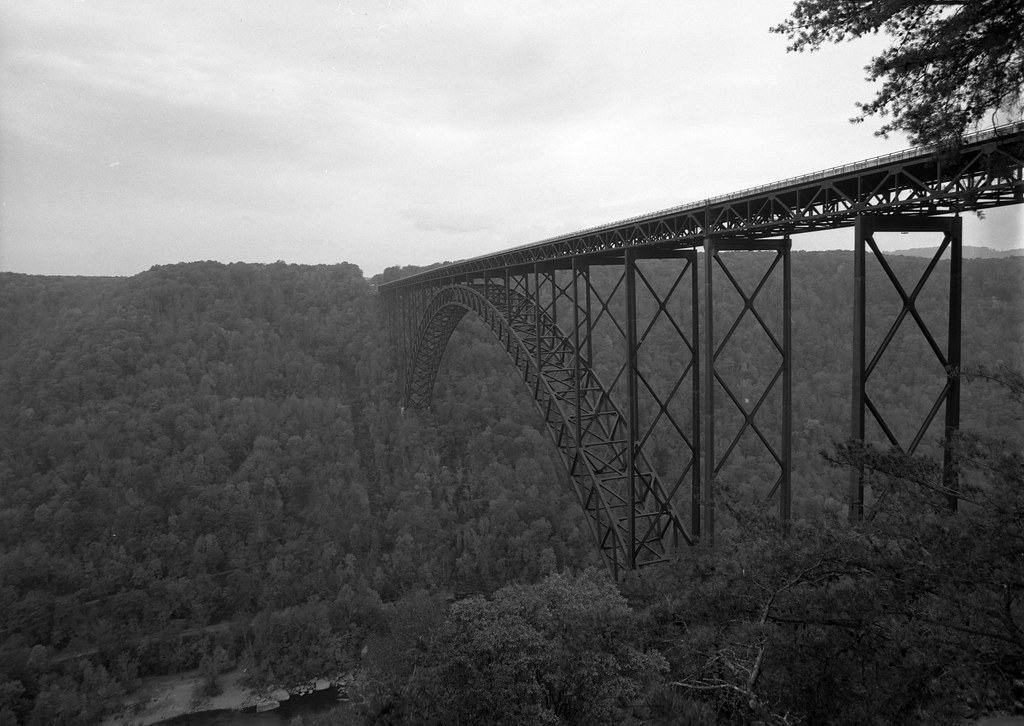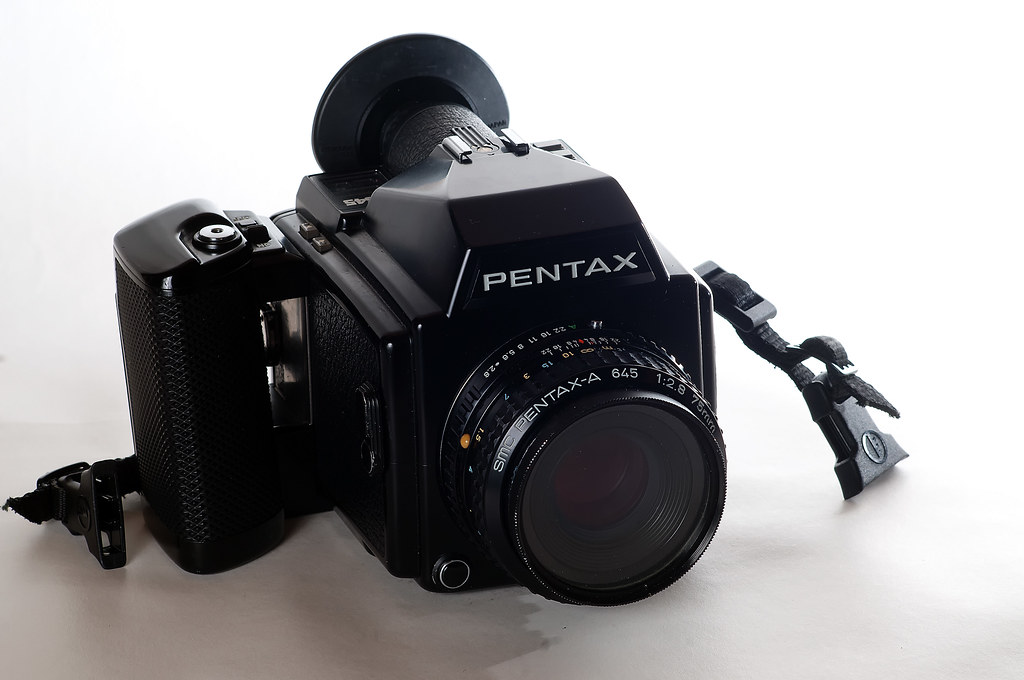I remember the first time I saw the Pentax 645; it was at Belle Art Camera in Hamilton, Ontario. It was sitting there in all its medium format beauty with the 75mm f/2.8 lens. The store employee told me all about the camera, what it did, how it worked. And I was looking to up my medium format game. The price was right, so I dropped the cash and left with a camera that would come with me on future trips, projects, and even some weddings. As a camera, the Pentax 645 is a workhorse and a working man’s camera, it has everything you want and needs all in one package. No addons or accessories required. And while I have since replaced the camera with another system (the Mamiya m645), the Pentax 645 is an excellent starter camera for anyone looking to get into the medium format without compromising your automation.
Camera Specifications
Make: Pentax
Model: 645
Type: Single Lens Reflex
Format: Medium Format (120/220/70mm), 6×4.5.
Lens: Interchangeable, Pentax K-Mount (645)
Shutter: Electronic Cloth Film Plane Shutter, 15″ – 1/1000″ + Bulb
Meter: Centre-Weighted TTL GPD Cell, EV3 – EV19 @ ASA-100, ASA-6 – ASA-6400
Year of Manufacture: 1984-1997


Background
Released under the radar in 1984, the Pentax 645 marked the companies second entry into the medium format SLR market. The first being the original Pentax 6×7 in the mid-1960s. The Pentax 645 featured a centre-weighted TTL meter that allowed for full auto-exposure along with metered manual, and semi-automatic shutter and aperture priority modes. The lenses were based around the Pentax-A with a scaled-up K-Mount. In true corporate form, Pentax designed the camera to have all the best features built into the camera body. In addition to the AE eye-level finder, they also included a motor drive. The Pentax 645 was not designed to be a system camera like their chief competitor the Mamiya m645, Mamiya would strike back in 1985 with the 645 Super which bears a resemblance to the Pentax. Pentax also released a series of thirteen lenses for the system, including one that had a leaf shutter. The Pentax 645 proved popular enough that Pentax released an autofocus version in 1997 that included several advancements such as exposure imprinting and matrix metering. Further advancements resulted in the Pentax 645N II in 2001, and the body provided the basis for the two digital versions the Pentax 645D in 2010 and 2014’s Pentax 645Z.


Impressions
For a camera that appears to be fairly brick-like, there is a certain style to the camera and its layout. The main body is one solid plastic piece, with metal internals. The whole camera is designed to work well and work together. There are no points of contact between the eye-level finder and the motor drive and the main body. It’s an all-in-one design. And while that means you cannot customise how to camera functions, it also means that once you get the body, you have it all. While the body alone would be fairly uncomfortable to hold, the grip makes the camera easy to function and operate. While not the most comfortable with the moulded plastic grip, it could be far worse. Control-wise everything you need is right at your fingertips with a big shutter release. A dedicated on/off switch is equally large. The only trouble is the control for adjusting the exposure settings. They would look more at home on a Pentax ME Super. A small LCD works well, and the other function buttons are on the other side of the prism, which does prevent accidental pushes. The viewfinder is big, bright, and has an old school bubble display. While the camera is not light, it isn’t too heavy. I’ve easily carried the camera around all day with little trouble, but you do want a good strap that can even go carbine style.


Experiences
The Pentax 645 is a shooters camera. Pentax did a solid job with making the camera easy to operate by photographers of any level of knowledge. Like the Pentax 67 cameras, the Pentax 645 is your standard SLR, while a little different in shape and form due to how everything works. The only thing to watch for is loading the film if you’re familiar with loading an insert style 645 camera then loading the film is easy. I only loaded it backwards once. Functionally the camera is a dream to use, in full AE, all you need to worry about is your composition and focus, the camera’s meter is excellent, and the viewfinder with the split prism makes focusing easy and composition a breeze. The mirror slap, shutter, and motor drive make a satisfying noise and even still presents little camera shake. I took the Pentax 645 everywhere, from travel to abandoned buildings. It worked great on a tripod and even had a second spot for a tripod mount to make it easy to switch quickly between landscape and portrait mode. The one thing that is a bit of a pain is that because it uses inserts you cannot hot-swap the film, you have to finish the roll before removing it.


Optics
If you like Pentax glass, then this camera is for you. The optics on this camera are among the best in the 645 format, in my opinion. It’s built to the same quality as the optics for the 67 system and 35mm systems. Designed to work with the automatic nature of the camera, make sure the aperture ring is set to A when using it in shutter priority or full AE. The best lens to start with is the 75mm f/2.8 which is a ‘normal’ lens for the system and is a sharp lens that will be a good carry around and a portrait lens in a pinch. But the one lens that shines with the system is the 35mm f/3.5 ultra-wide lens. As you can see, most of the example images in this review were shot with this lens. Honestly, once I had the lens, it seldom left the camera body. With sharpness corner to corner and little distortion, for the style of shooting I did, it was the perfect lens. I would avoid the zoom lenses, I also had the 80-150mm lens, and it hardly saw any use, the longer telephoto lenses change the centre of gravity and overall balance of the camera overall. But if you are doing some portrait work or need that extra reach, the 150/3.5 is a good choice. An added plus is that the lenses are not too expensive on the used market and more people go after the new autofocus versions.


Lowdown
Surprisingly these days you can get your hands on a Pentax 645 system for a low cost. An original model with a film insert will run you around 150$ and another 150$ or so for the 75/2.8, and you have a kit ready to rock and roll for around 300$. The additional lenses can cost a bit more, but if you’re good and watch sites like eBay or KEH, you’ll find some good deals. The newer versions will cost far more along with the lenses. Just make sure that it comes with a 120 insert. As a kit goes, the Pentax 645 will serve you well as an entry-level medium format camera, especially if you’re not comfortable with systems or manual exposures. Being made in the mid-80s to late-90s, they are fairly young compared to other similar cameras, and while repair remains a big question mark, the only trouble I ever had with mine was running out of batteries. Thankfully, the camera takes six AA batteries which can be easily had anywhere. I was in Northern Ontario and stopped in at a gas station between Timmins and Sudbury where I couldn’t get a cell signal, but got the AA batteries and gas for the car. While I don’t regret selling the camera, I had by that point not used the camera in almost a year. It is a system that I will always recommend for those looking for that crack in the door.


Further Reading
Don’t just take my word on the Pentax 645, you can check out the reviews by other awesome camera reviewers!
Emulsive – Camera Review: My journey with the Pentax 645
Casual Photophile – Pentax 645 Camera Review: The Best Entry Level Medium Format Camera.
Jake Horn Photography – Pentax 645 Review
Louisville Wedding Photographers – Pentax 645 Review
